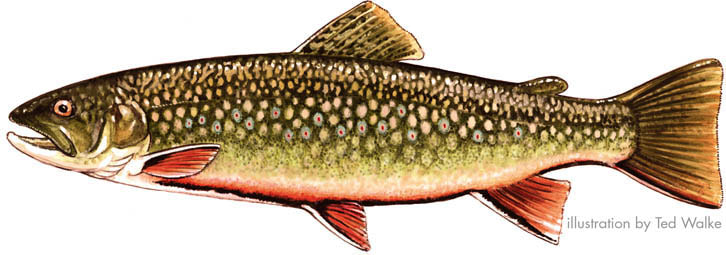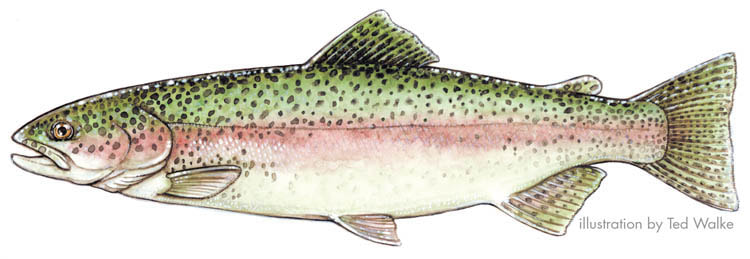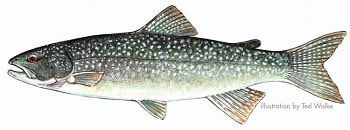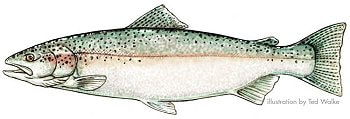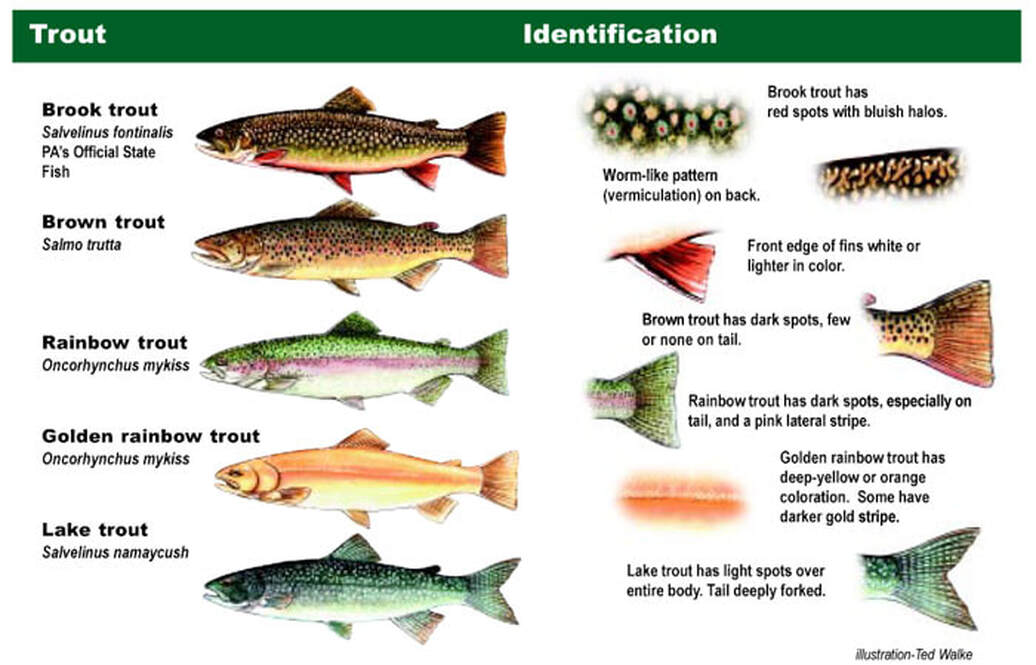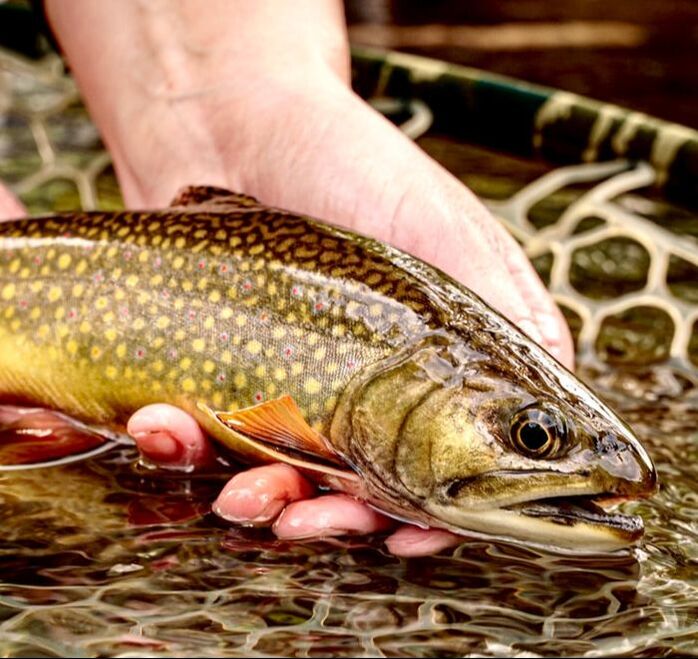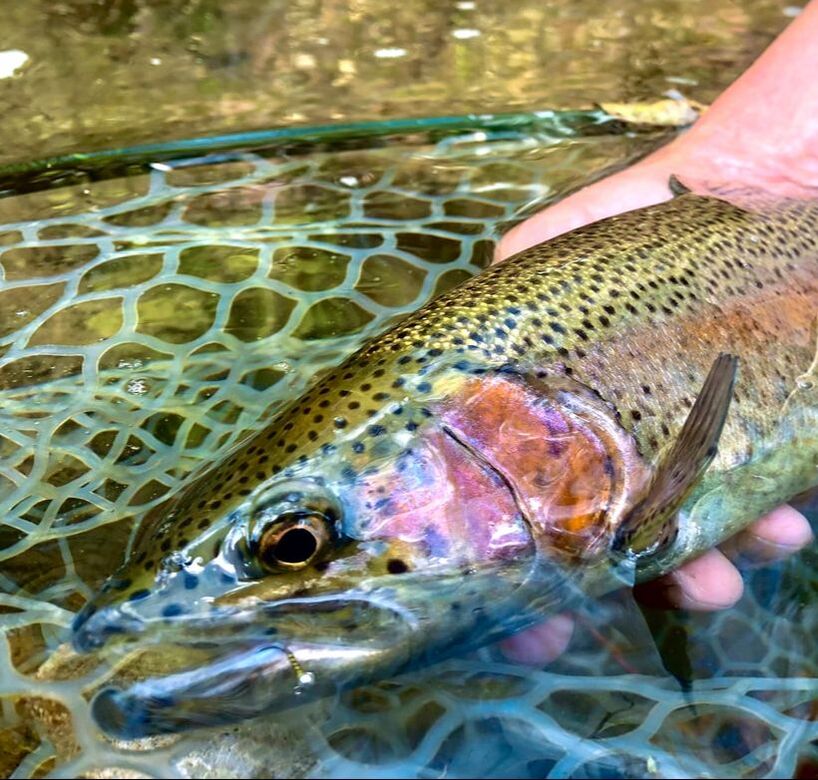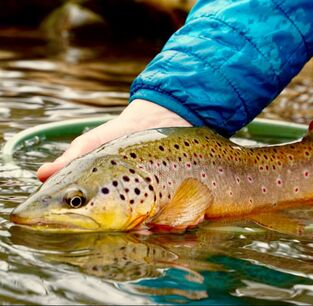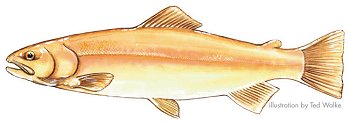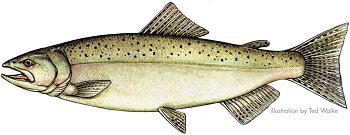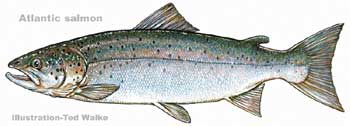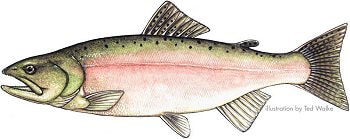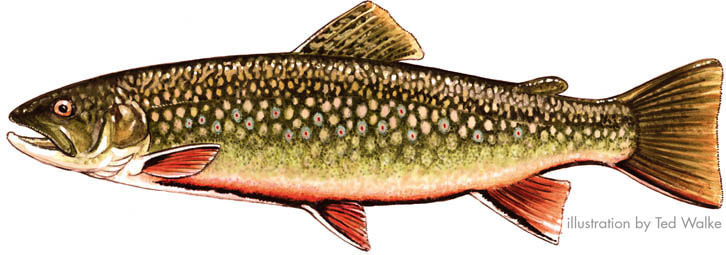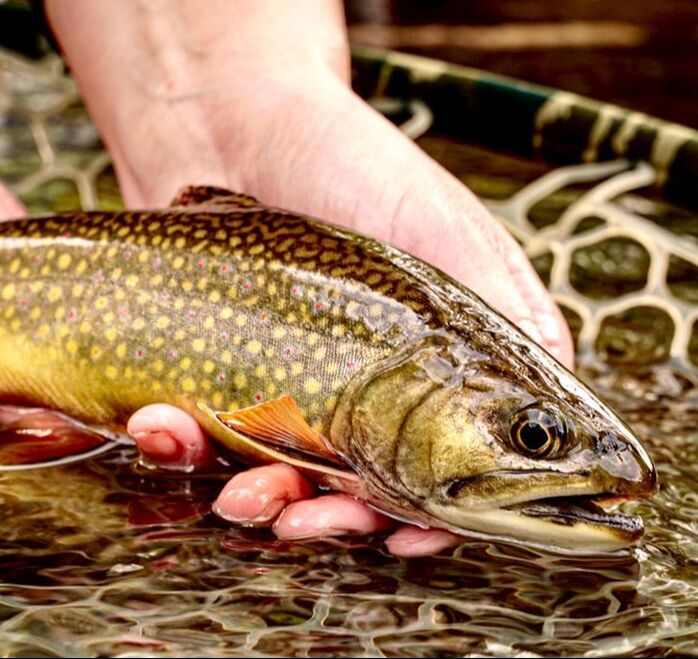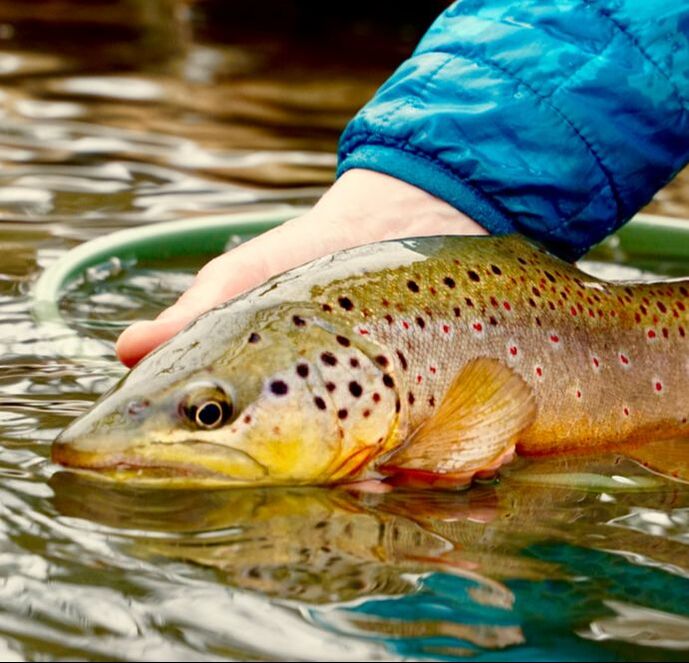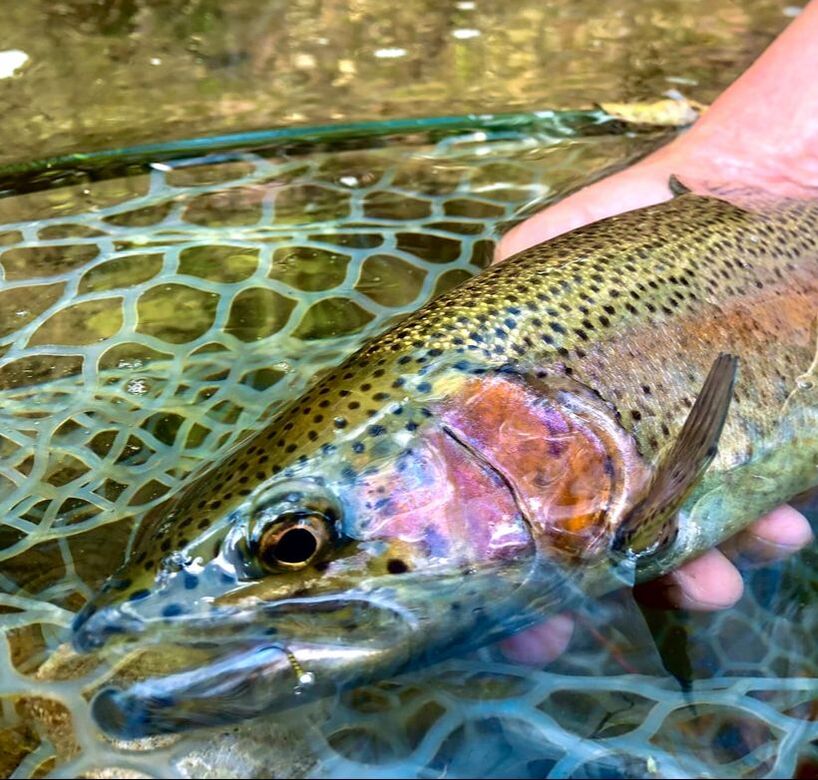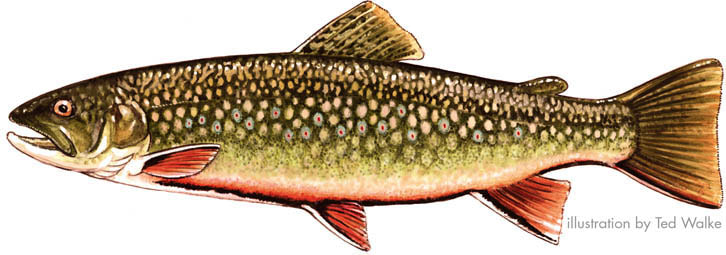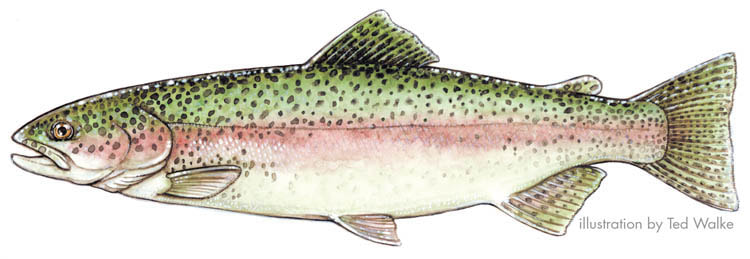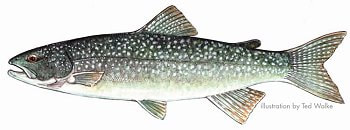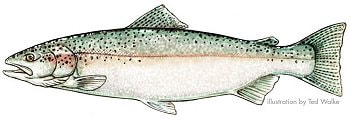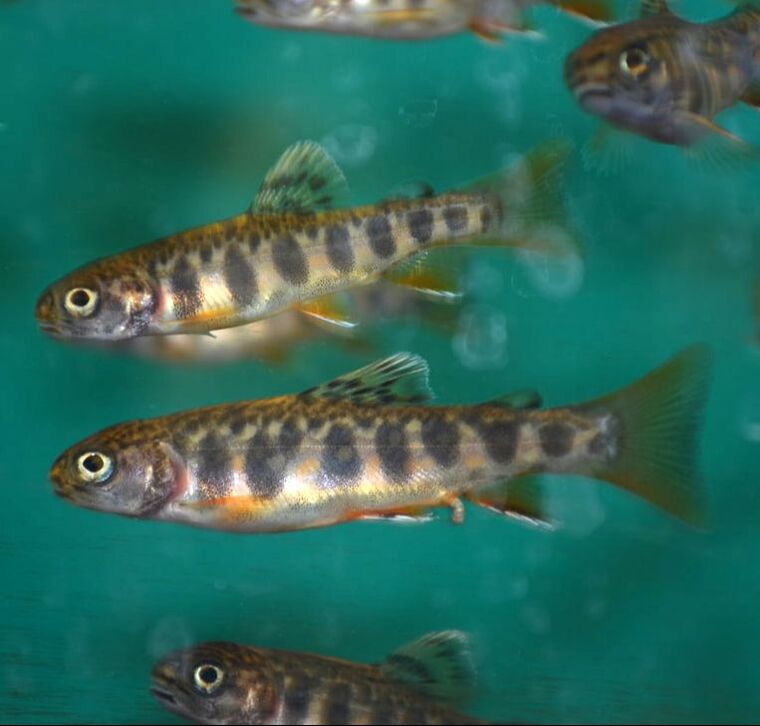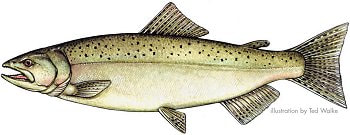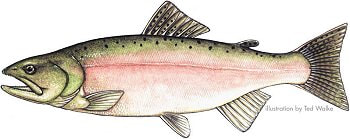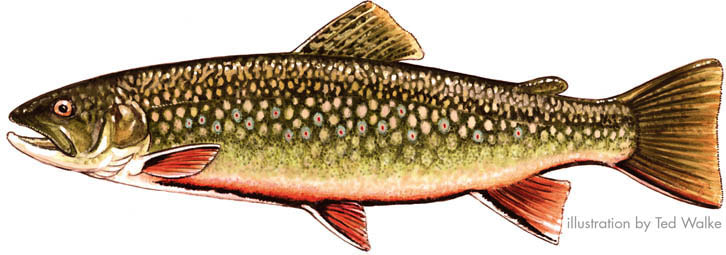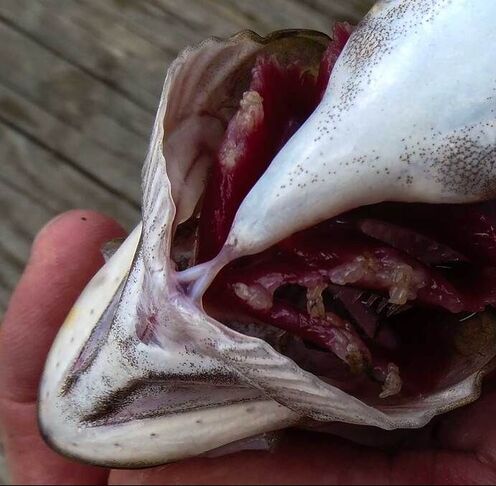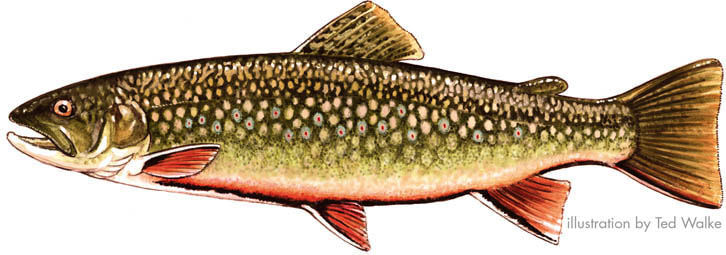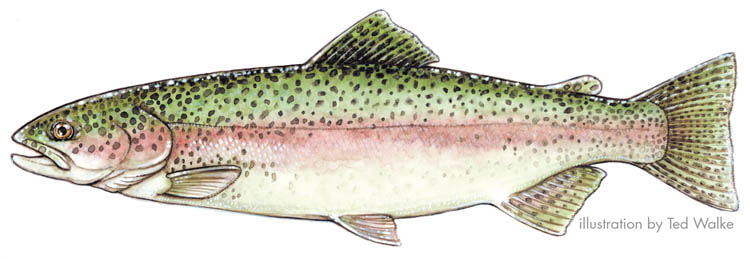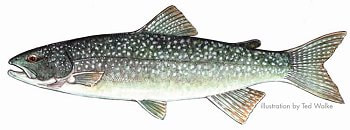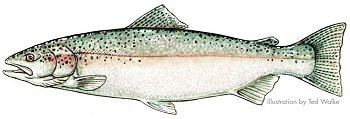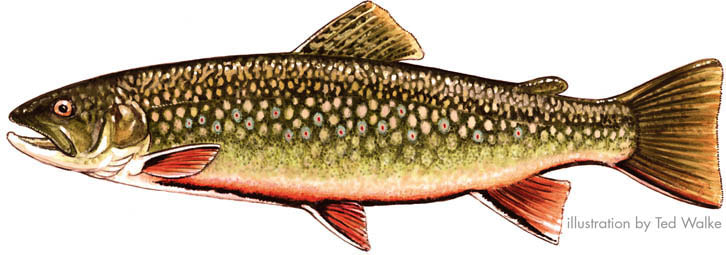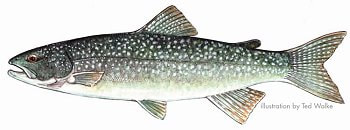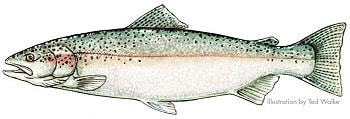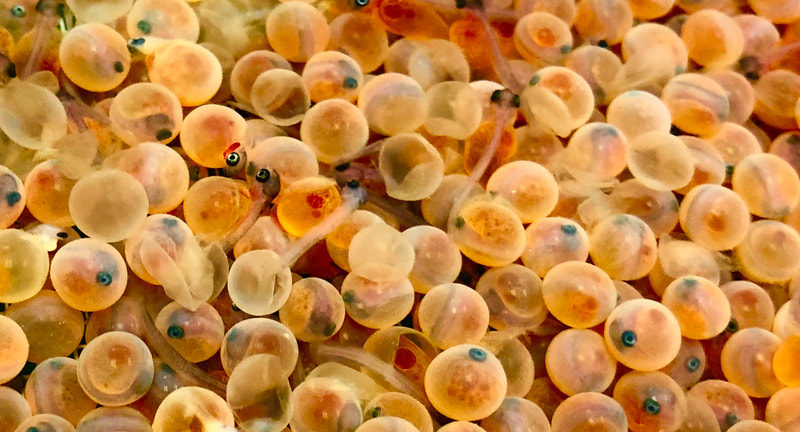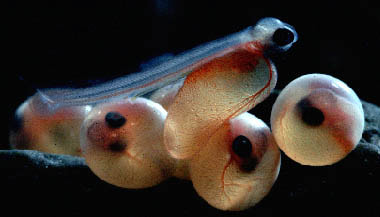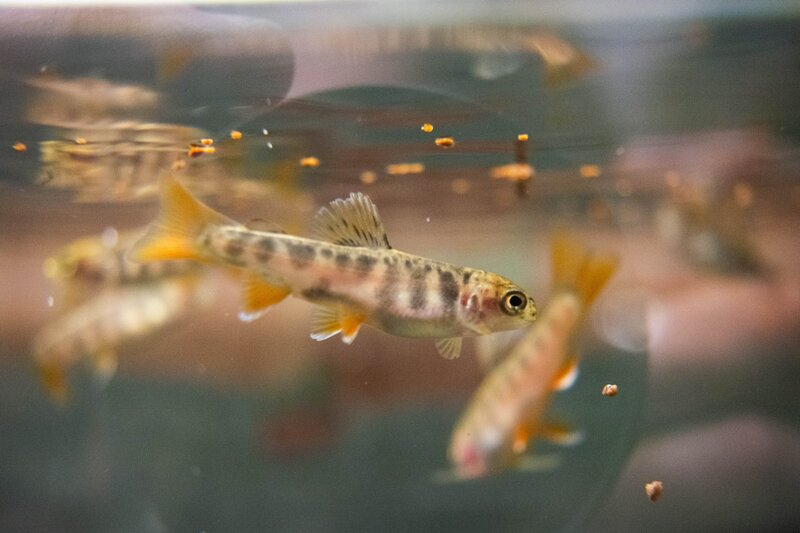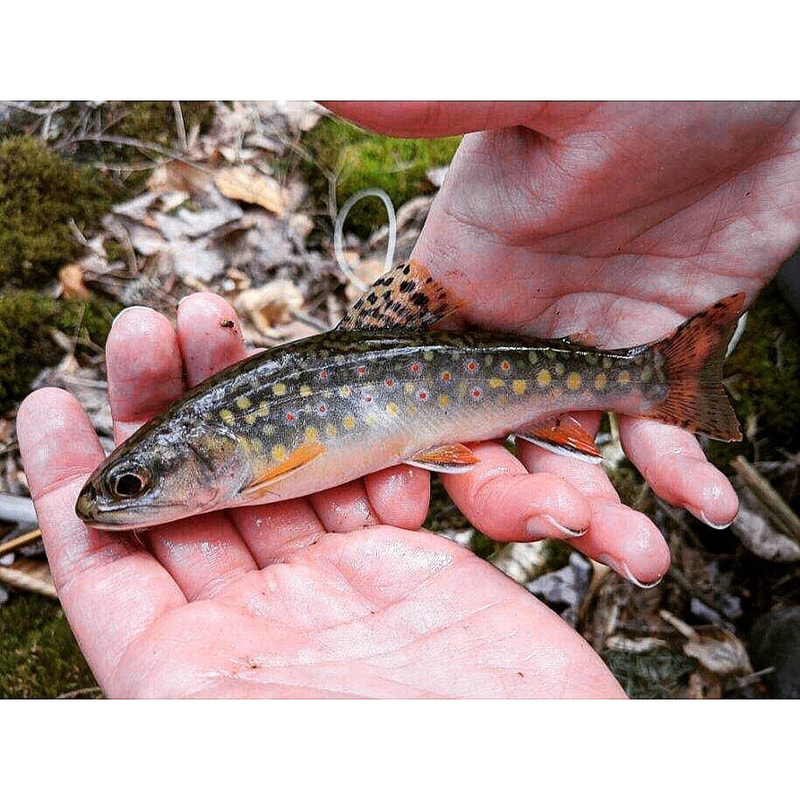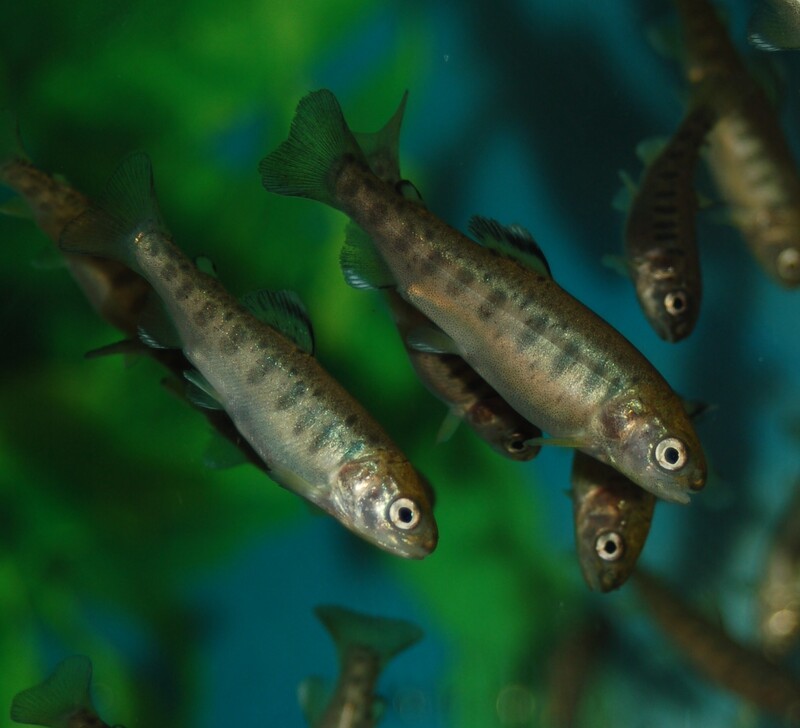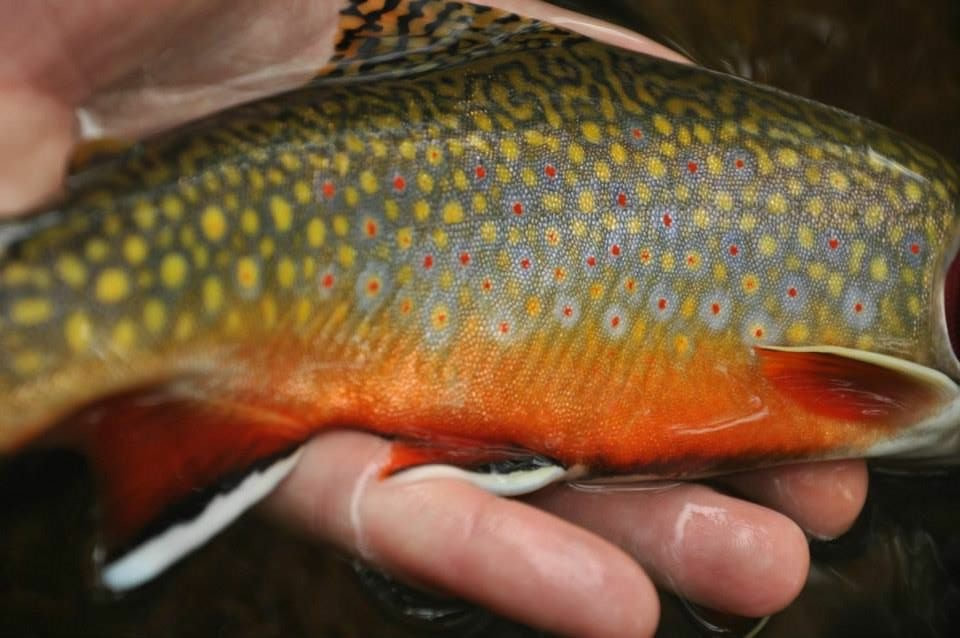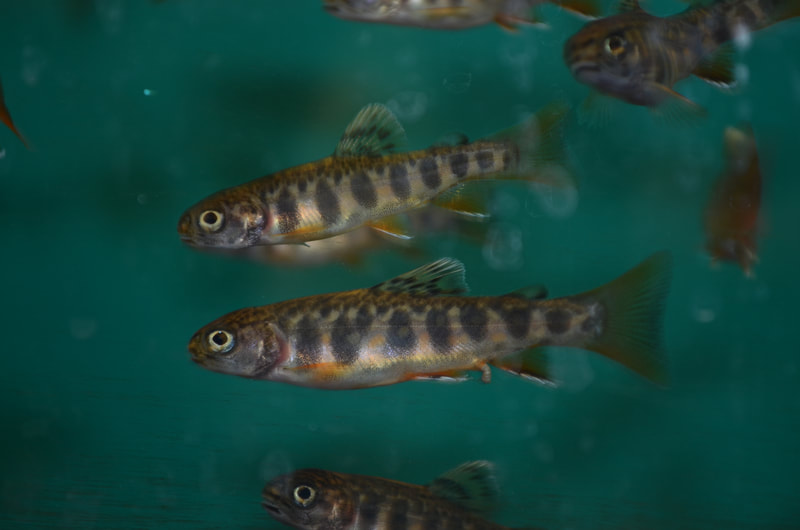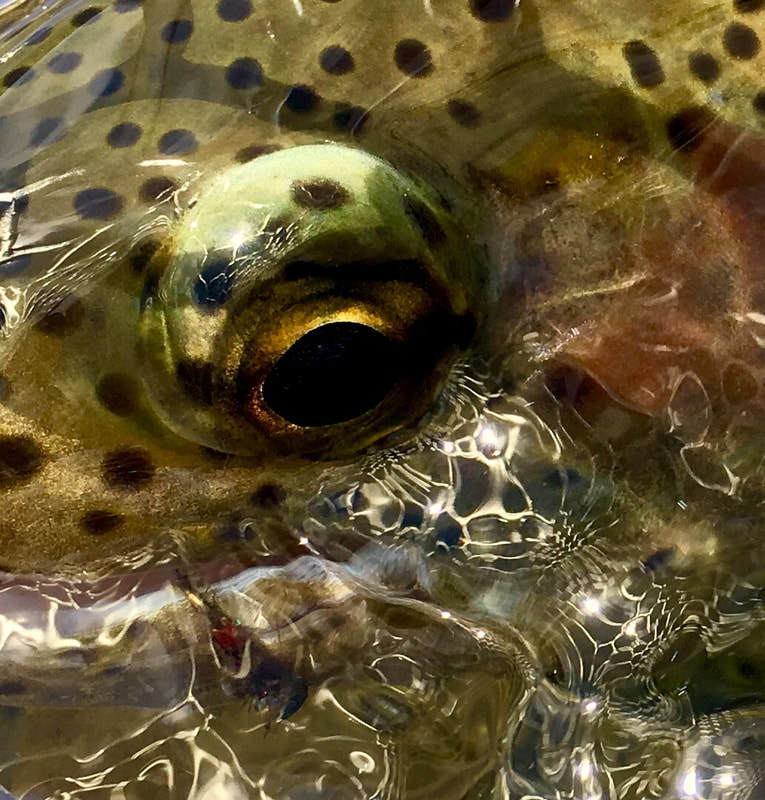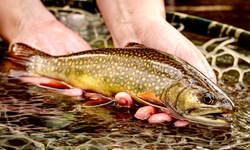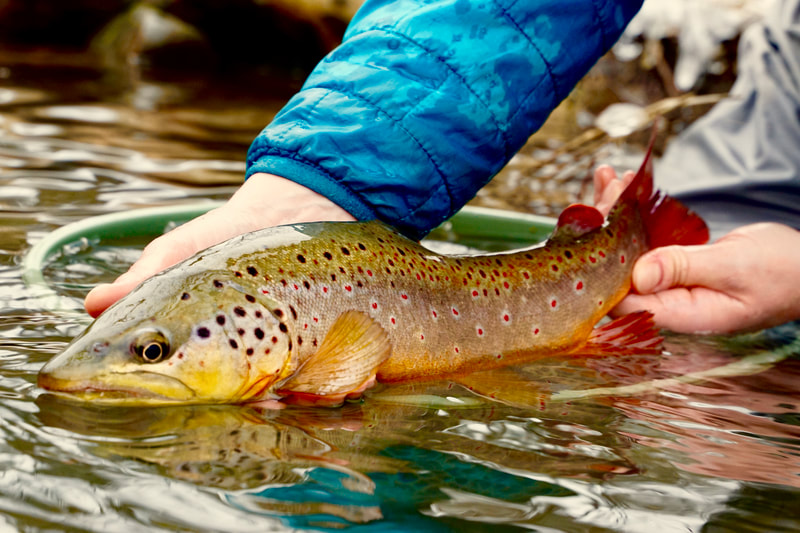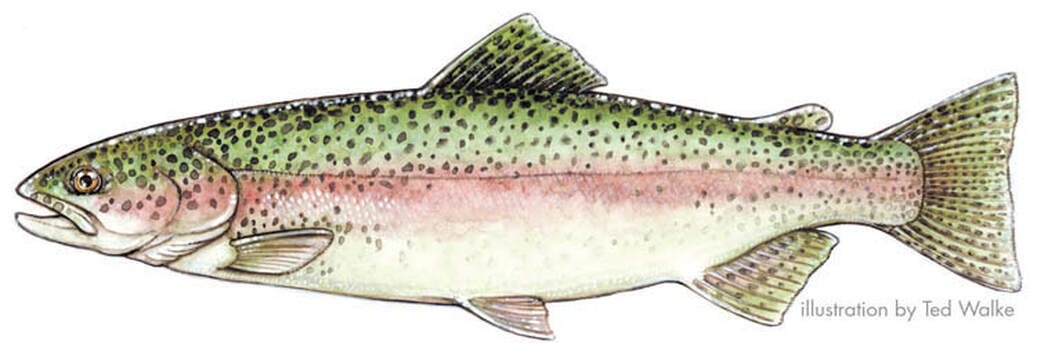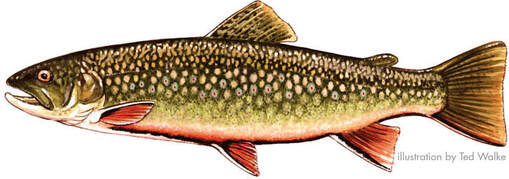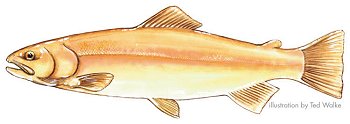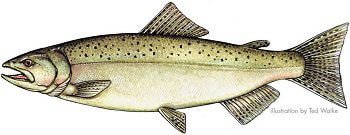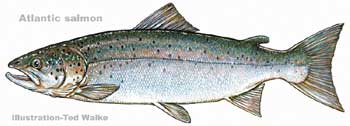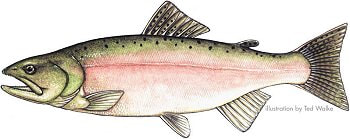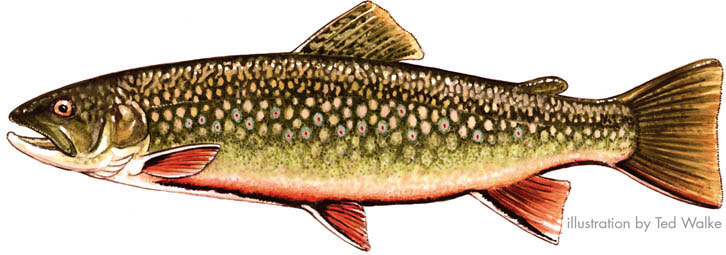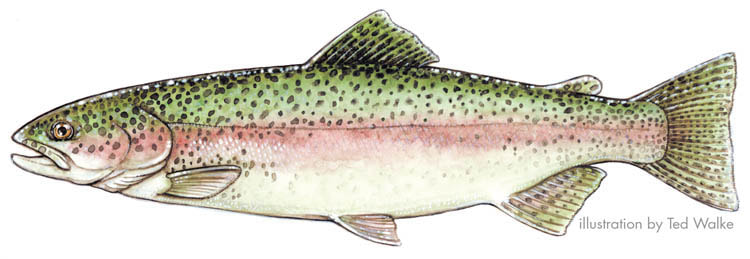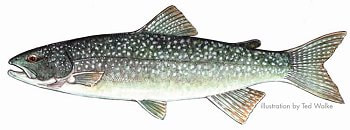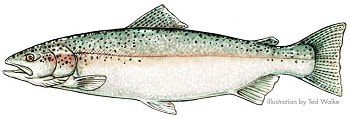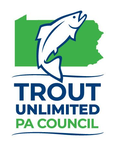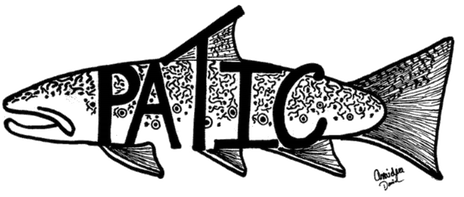Family Overview
Family Salmonidae, the trout and salmon family, includes great game fish like trout, salmon, chars and grayling, as well as food and baitfishes like whitefish and ciscoes. The trout and salmon family is large. It is native to cool and cold streams and lakes throughout Europe, northern Asia and North America, and reaches as far south as northwest Mexico and extreme northern Africa. One family member, the Arctic Char, is the freshwater fish that occurs the farthest north. Because of their popularity for sport and commercial fishing, this family has been stocked in waters worldwide and is now found on nearly every continent.
Many trout that anglers catch in Pennsylvania are the result of the stocking of hatchery-raised fish. However, where streams are cold and clean enough, with proper spawning habitat, Pennsylvania also has a wealth of reproducing populations of wild trout. In Pennsylvania, the trout and salmon family includes three species of the genus Coregonus, all native and found in Lake Erie: the rare Longjaw Cisco, the Cisco or Lake Herring, and the Lake Whitefish–silvery well-scaled fishes with deeply forked tails. The Whitefish is currently an important commercial species. It has rebounded with reductions in the numbers of Sea Lampreys and Rainbow Smelt. Rainbow Smelt were believed to prey on whitefish eggs and young.
Other members of the trout family native to Pennsylvania, not introduced, are Chars of the genus Salvelinus: the Brook Trout and the Lake Trout. Brook Trout remain the only wild trout native to Pennsylvania's inland streams and rivers, while the four other native species (Longjaw Cisco, Cisco or Lake Herring, Lake Whitefish, and Lake Trout) inhabit the state's lakes.
Many trout that anglers catch in Pennsylvania are the result of the stocking of hatchery-raised fish. However, where streams are cold and clean enough, with proper spawning habitat, Pennsylvania also has a wealth of reproducing populations of wild trout. In Pennsylvania, the trout and salmon family includes three species of the genus Coregonus, all native and found in Lake Erie: the rare Longjaw Cisco, the Cisco or Lake Herring, and the Lake Whitefish–silvery well-scaled fishes with deeply forked tails. The Whitefish is currently an important commercial species. It has rebounded with reductions in the numbers of Sea Lampreys and Rainbow Smelt. Rainbow Smelt were believed to prey on whitefish eggs and young.
Other members of the trout family native to Pennsylvania, not introduced, are Chars of the genus Salvelinus: the Brook Trout and the Lake Trout. Brook Trout remain the only wild trout native to Pennsylvania's inland streams and rivers, while the four other native species (Longjaw Cisco, Cisco or Lake Herring, Lake Whitefish, and Lake Trout) inhabit the state's lakes.
To learn about the specific life histories and characteristics of common Pennsylvania trout, please explore our trout species profiles:
To learn more about the history of trout provided in the PA TIC program, explore a gallery of quality trout images/illustrations, and so much more, please continue reading below!
What’s This Trout? Comparing Native, Wild, and Hatchery Fish
Pennsylvania has an impressive diversity of fishes within the Family Salmonidae., However, in conversation and in text, they are sometimes referenced using varying terminology. For example, it is not uncommon to hear an angler mention phrases such as: “I’m going to spend the day fishing for natives,” or “Wow! That is a beautiful fish! I’m sure it is wild.”
One might also find themselves reading about the 3.2 million hatchery-reared trout that the PFBC stocks into approved stocked trout waterways each year. All of this vocabulary can become quite confusing when it comes to correctly recognizing a fish for what it may or may not be. What constitutes the difference between a native fish, a wild fish, and a hatchery fish? The best way to understand how to properly categorize these fishes is to have clear definitions for the terminology used.
Native fishes are those species of fish that occurred historically and naturally in Pennsylvania’s waterways before any human involvement.
One might also find themselves reading about the 3.2 million hatchery-reared trout that the PFBC stocks into approved stocked trout waterways each year. All of this vocabulary can become quite confusing when it comes to correctly recognizing a fish for what it may or may not be. What constitutes the difference between a native fish, a wild fish, and a hatchery fish? The best way to understand how to properly categorize these fishes is to have clear definitions for the terminology used.
Native fishes are those species of fish that occurred historically and naturally in Pennsylvania’s waterways before any human involvement.
|
It is known that the Brook Trout is the only native salmonid to Pennsylvania’s inland rivers and streams. This means that historically these populations were the only salmonids that could be found inland within Pennsylvania. The Rainbow Trout and Brown Trout populations that can be found today are considered non-native species and were introduced through human intervention. The Brook Trout is Pennsylvania’s only inland salmonid that can be classified as both native and wild. Understand that this does not indicate that Rainbow Trout and Brown trout cannot be referenced as wild fishes.
|
|
Wild fishes are those species of fish that were born and grew up within the stream, river, or lake.
Populations of wild Brown Trout have been documented in many waterways throughout Pennsylvania. Even though Brown Trout are classified as a non-native species in Pennsylvania, it is very common for them to be referenced as wild if, in fact, that fish was born within the waterway with no human intervention. The same can be said for some populations of Rainbow Trout in Pennsylvania. This is not the case for fishes that were born and reared within a hatchery setting. Hatchery fishes are those species of fish that are spawned and reared within the hatchery system. Every year, Pennsylvania stocks hatchery trout into approved waterways throughout the state. These fishes provide angling opportunities for the public in many lakes, river and streams where anglers would otherwise not have the opportunity to experience catching them. The PFBC stocked, hatchery-reared Brook, Brown, and Rainbow Trout are NOT classified as wild fishes. Regardless of reference or status, Pennsylvania’s salmonids – whether native, wild, or hatchery – require cold, clean water and ultimately play a role in ecosystem health and ecology. |
The PA TIC program further enforces this fact through education and interpretation, giving students the opportunity to learn more about Pennsylvania’s important aquatic resources.
History of Trout Provided in PA TIC
Today, the Pennsylvania Fish and Boat Commission (PFBC) provides Rainbow Trout to all registered PA TIC participants. Historically, however, this is not the only species students have raised from eggs to fingerlings in the PA TIC program. In the beginning (2006-2007), PA TIC participants visited a local hatchery to choose the type of trout eggs they wanted to raise in their classrooms. Trout selected included Brook, Rainbow, or Brown Trout.
|
In 2008, with the program gaining more popularity and interest, PFBC began providing trout eggs from one state hatchery to streamline the PATIC program’s source of eggs, shipment process, and fish health, and to direct where the trout were allowed to be released (e.g., Stocked Trout Waters). At that time, the trout of choice was the Brook Trout (Salvelinus fontinalis), the state fish of Pennsylvania and the only salmonid (trout/salmon) native to Pennsylvania's streams, unlike the non-native Rainbow and Brown Trout, also populous in the state's waters. Although all eggs used in the program originate from stocked, hatchery-reared trout rather than wild trout, the PA TIC program's use of Brook Trout helped deepen students' understanding of the value of native species in healthy watersheds.
|
For nearly a decade, PFBC continued to provide Brook Trout (Salvelinus fontinalis) as the “TIC Trout." Then, in 2016, fisheries biologists began to receive increased angler reports of parasitic Gill Lice (Salminocla edwardsii) being found on Brook Trout, not only in stocked trout waters, but also in native trout waters. This type of Gill Lice is “host-specific” to the Char family, meaning that in Pennsylvania it exclusively parasitizes the Brook Trout. Simultaneously, PFBC fisheries biologists were implementing statewide management strategies to minimize conflicts between hatchery Brook Trout and PA’s Wild Brook Trout populations. In 2019, PFBC made a proactive decision to decrease Brook Trout stockings statewide, first within the PFBC hatchery system and then within the PFBC’s Cooperative Nursery Program.
As the responsible organization for Pennsylvania's aquatic resources and the provider of PA TIC trout eggs, PFBC extended this decision to the PA TIC program. Beginning with the 2019-2020 PA TIC school year, PFBC switched from using Brook Trout to using Rainbow Trout as the source for TIC eggs. This transition represented an important effort to conserve and protect Pennsylvania’s native Wild Brook Trout populations.
As the responsible organization for Pennsylvania's aquatic resources and the provider of PA TIC trout eggs, PFBC extended this decision to the PA TIC program. Beginning with the 2019-2020 PA TIC school year, PFBC switched from using Brook Trout to using Rainbow Trout as the source for TIC eggs. This transition represented an important effort to conserve and protect Pennsylvania’s native Wild Brook Trout populations.
The program’s current use of Rainbow Trout eggs does NOT mean Brook Trout and native-species education no longer have a place in participants' hearts and classrooms. As the only salmonid native to the rivers and streams across the eastern United States, it is deeply important that students and teachers not only understand the proactive decision made by PFBC to protect Brook Trout populations, but also the important role that native Brook Trout play in coldwater ecosystems and the history of Pennsylvania's waters.
PA TIC partners and teachers are encouraged to explore the link between native species and healthy watersheds, while the live Rainbow Trout provide a unique learning experience for students to intimately study trout life cycles, aquatic adaptations, coldwater ecosystems, non-native species, and so much more!
PA TIC partners and teachers are encouraged to explore the link between native species and healthy watersheds, while the live Rainbow Trout provide a unique learning experience for students to intimately study trout life cycles, aquatic adaptations, coldwater ecosystems, non-native species, and so much more!
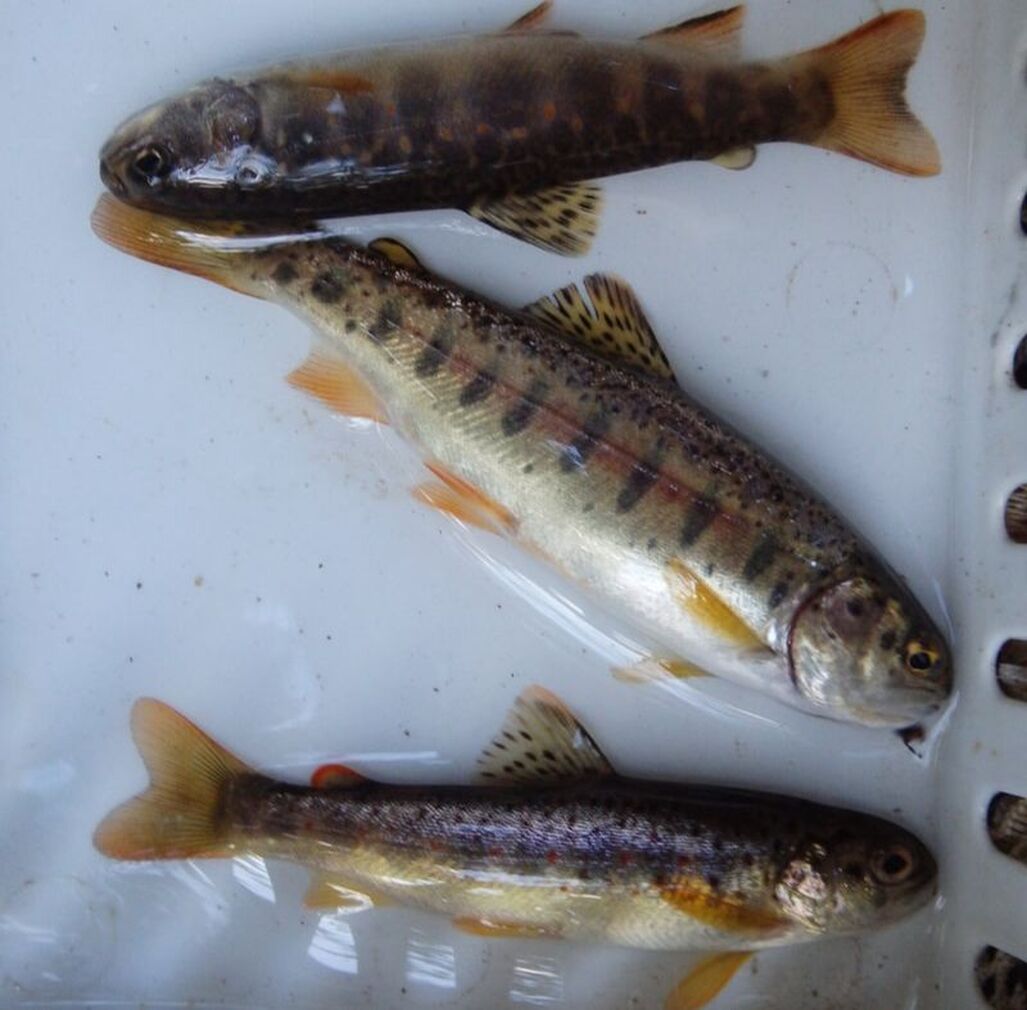
Brook Trout (top), Rainbow Trout (middle) and Brown Trout (bottom) fingerlings collected and released safely during a PFBC fish community survey. While the trout fingerlings are beginning to exhibit the unique markings and colors that define their species, all three fingerlings or "parr" bear longitudinal "parr marks." These stripes provide important camouflage and protect the fingerlings from predators.
Why Rainbow Trout?
The Science Behind the Shift
As the TIC program continues to grow—from 90 PA TIC programs in 2008 to roughly 415 programs in 2019—we are always seeking new ways to continue maintaining a sustainable program. Such a program benefits TIC teachers, students, and program partners, but also does not impact Pennsylvania's water resources. Our program should have:
|
big impacts on students
|
and
|
small impacts on water resources
|
|
A difficult but necessary milestone in our sustainable program model occurred in the 2019-2020 school year, when PFBC switched to Rainbow Trout eggs for the PA TIC programs. This shift from hatchery-reared Brook Trout to hatchery-reared Rainbow Trout was part of an ongoing management strategy to continue the enhancement and protection of Pennsylvania's wild native Brook Trout populations and their coldwater environs from threats, such as:
|
Gill Lice are a current and real issue for PA’s Wild Brook Trout populations. In 2016, fisheries biologists began to receive increased angler reports of the species of Gill Lice that is host-specific to Brook Trout, not only in stocked trout waters, but also in native trout waters. Among these reports were the first incidents of parasitic Gill Lice on Pennsylvania’s wild inland Brook Trout, or those Brook Trout not associated with Lake Erie drainages. Although Gill Lice are not linked directly to fish mortality, the parasites are linked to a decrease in respiration (Gill Lice are attached to the gills) and increased susceptibility to warming temperatures, thereby negatively impacting a Brook Trouts’ overall survival. Continued stocking of hatchery-reared Brook Trout, including those released in PA TIC, could potentially exacerbate the risk of wild native Brook Trout being parasitized and, by extension, inhibit the survival of these important populations.
Want to learn more about Gill Lice? Watch this presentation by PFBC Fish Health Unit Leader Coja Yamashita on the presence and impact of Gill Lice on Wild Brook Trout populations:
Want to learn more about Gill Lice? Watch this presentation by PFBC Fish Health Unit Leader Coja Yamashita on the presence and impact of Gill Lice on Wild Brook Trout populations:
How does a TIC year with Rainbow Trout compare to a year with Brook Trout?
1. Rainbow Trout tend to do better in a “closed system” environment (e.g., aquariums).
- This doesn’t mean we won’t have ANY troubleshooting issues, but it may help decrease some of the concerns/issues experienced during PA TIC years with Brook Trout.
- Later delivery = Less end of year stress
- With the trout arriving later in the school year, there is less of a chance that your aquarium will reach carrying capacity before the end of the school year, meaning you won't have to do as many water changes or release trout early.
- This will allow you to pre-cycle your tank prior to receiving eggs and begin utilizing the tank to support your curriculum prior to the egg shipment date after the New Year holiday.
- All resources found sitewide should reflect the most up-to-date program overview, classroom objectives, and getting-started tips. This includes a revised timeline for your PA TIC program based on the use of Rainbow Trout eggs in place of Brook Trout for future school years.
Thank you for your continued dedication to connect youth to PA’s coldwater resources, and thank you for your support in our efforts to protect PA’s Wild Brook Trout populations!
Gallery of PA TIC Trout
Looking for high-quality photos and illustrations of trout to include in your program presentations, handouts, and lessons? Please click of the images below to enlarge them. All images found below and sitewide may be downloaded for educational purposes; images may not be used for selling or distribution.
Thank you to the teachers and partners who contributed to the gallery below.
Thank you to the teachers and partners who contributed to the gallery below.
Today's PA TIC students raise hatchery-born Rainbow Trout from eggs to fingerlings in an aquarium "coldwater ecosystem," but students have historically used hatchery-born Rainbow Trout, Brook Trout, and Brown Trout! Click each illustration below to view it for downloading. Can you spot each trout's identifying characteristics using PFBC's Trout Identification guide?
Want more quality trout illustrations from Ted Walke? Explore the Trouts and Salmons of PA on the PFBC website.
All About Trout Resources
Explore the below educational resources from the Pennsylvania Fish and Boat Commission (PFBC). These resources, along with many others from environmental education providers across the state, can also be found under Curriculum Connections.
Aquatic Organisms (Trout and MORE!)
Watersheds
Recreational Fishing
- All About Trout PLAY Youth Newsletter
- Aquatic Critters Fact Sheets (e.g., Mayflies, Stoneflies, Caddisflies, and more!)
- Aquatic Field Study Permitting: Permit needed to collect macroinvertebrates in PA, even if you release them
- Brook Trout Life Cycle Poster
- Fish Habitat Improvement, featuring project maps, videos, PowerPoint presentations, and a booklet
- PLAY (Spring 2006) – Six Legs Underwater (Learn fun facts about insect family tree, how they eat and more!)
- PLAY (Spring 2013) Fish Scene Investigation (Learn how biologists study and manage fish populations in PA)
- Trout Identification
- Trouts and Salmons of PA
- Trout Water Classifications
Watersheds
- Pond and Stream Study Guide
- PLAY (Winter 2019) – Water Flows Through PA
- PLAY (Fall 2019) H20 On the Go
- PLAY (Spring 2018) Water, Water, Read All About it! (water temperature, pH, Alkalinity, Turbidity)
- PLAY (Winter 2013) Good Fishing, Needs Good Habitat (Recipe for a healthy stream, stream and lake habitat toolbox, help this stream activity)
- Wetlands and why do fish need them
- Timbering and Trout
Recreational Fishing
